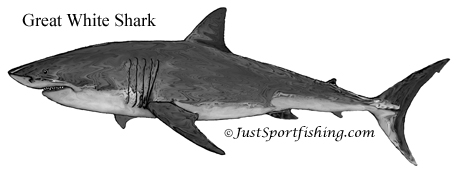|
Home Game Fish Fishing Knots Tackle Tips Videos Pictures Tips Rods & Reels Boats Cook your Catch Articles About Contact |
|
Donate to JustSportfishing.com and help to build the largest fishing information site on the web. Even a dollar or two will keep us building this free site. |
Great
White Shark World
Record
~ 2664 Lbs Caught at Ceduna, S. Australia on Apr. 21, 1959 by angler
Alfred Dean Scientific
name
~ Carcharodon Carcharias Other
names
~ Great White, and White
Pointer, White Death Identification
~ The Great White Shark has
a stout, heavy body that is slate blue, grayish, or almost black along
the back and upper sides. The belly is white, there are black edges on
the pectoral fins and often there is a black oval blotch on the body
just above or behind the fins.The great white shark has a large cone
shaped head with the snout ending in a point Size
~ Adult white sharks grow to about 21 ft. long and dominate their domain
as one of the top-level predators of the ocean. A typical adult great
white shark measures 13 to 16 ft with a typical weight of 1,500 to 2,450
lb, females generally being larger than males. A female white shark was
captured off Pt. Vincente in September 1986 that measured 17.6 ft and
weighed 4,140 lbs. Habitat
~
The white shark is found worldwide but occurs mostly in temperate seas,
with large individuals known to penetrate tropical waters. It makes
sporadic movements to cold, boreal waters and has been recorded off
Alaskan and Canadian coasts. The white shark spends most of its time
living in the upper part of the water column and is a dweller of
nearshore waters. However, it ranges from the surfline to well offshore
and from the surface and to depths over 775 ft. This shark commonly
patrols small coastal archipelagos inhabited by seals, sea lions and
walruses, offshore reefs, banks and shoals and rocky headlands where
deepwater lies close to shore. The white shark usually cruises in a
purposeful manner, either just off the bottom or near the surface, but
spends very little time at midwater depths. Feeding
Habits
~ Its most important prey items are marine mammals, including, seals,
sea lions, elephant seals, dolphins and fish including other sharks and
rays.
|


